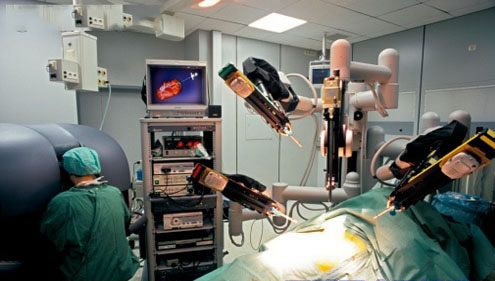

 |
| A doctor uses a machine to perform a surgery. |
Believe it or not, today’s robots can not only be professional Go players, they can also qualify as expert surgeons.
Recently, a British teenager named Billy Whitaker had his epilepsy cured thanks in part to the efforts of a robot surgeon. With minute accuracy, the robot pinpointed the epicenter of Whitaker’s debilitating attacks and drilled electrodes deep into his brain to remove the tiny piece of seizure-causing tissue.
Whitaker’s case was not the first instance of robots successfully performing surgery. To qualify as a robot surgeon, a robot must possess three major items: sufficiently advanced software and hardware (a brain), a sensor (eyes), and electromechanical devices (hands).
The “brain” works similarly to our computers at home, but its operating system is usually optimized to increase the stability of its software. “Eyes” usually refers to features like pressure sensors and/or video image capture devices. The “eyes” are in charge of collecting information and transferring it to the “brain,” which then issues commands for the “hands” to perform.
Most medical robots today are based on “Leonardo’s robot,” a design originally completed by Leonardo da Vinci in the 15th century and rediscovered in the 1950s. Doctors sit in front of a screen and use a sort of joystick to perform surgeries. The most important feature of these surgeries is that doctors are able to adjust the scale based on specific needs, which is especially beneficial for delicate and hyperfine surgeries. However, these ”robot surgeries” are usually much more expensive than regular ones.
In addition to robot surgeons, there are also robot chefs and robot executives. With the rapid development and increasing use of artificial intelligence across many fields, it is likely that more and more robots will make significant contributions to humanity.
 Train rides through blossoms
Train rides through blossoms HD pictures of battleships of PLA Navy
HD pictures of battleships of PLA Navy East Sea Fleet conducts combat drills
East Sea Fleet conducts combat drills Sophie Marceau goes square dancing in Guangzhou
Sophie Marceau goes square dancing in Guangzhou Police officers learn Wing Chun in E. China
Police officers learn Wing Chun in E. China Charming models compete in super model contest in Beijing
Charming models compete in super model contest in Beijing Thai most beautiful transgender Nong Poy release new photos
Thai most beautiful transgender Nong Poy release new photos Now and then photos of Shanghai Jiaotong University
Now and then photos of Shanghai Jiaotong University Is this what air travel will look like in 2050?
Is this what air travel will look like in 2050? Top 20 hottest women in the world in 2014
Top 20 hottest women in the world in 2014 Top 10 hardest languages to learn
Top 10 hardest languages to learn 10 Chinese female stars with most beautiful faces
10 Chinese female stars with most beautiful faces China’s Top 10 Unique Bridges, Highways and Roads
China’s Top 10 Unique Bridges, Highways and Roads Cyber-celebrity culture is warping Chinese youth
Cyber-celebrity culture is warping Chinese youth Threatened boycott puts Asia's top film fest in crisis
Threatened boycott puts Asia's top film fest in crisis Pet funeral homes help grieving owners gain closure
Pet funeral homes help grieving owners gain closure Lesbian couples resort to foreign sperm banks to evade domestic restrictions
Lesbian couples resort to foreign sperm banks to evade domestic restrictionsDay|Week